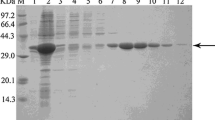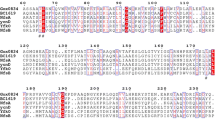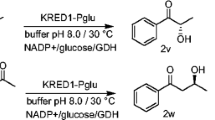Abstract
Two cytosolic NADPH-dependent carbonyl reductases from Gluconobacter oxydans 621H, Gox0644 and Gox1615, were heterologously produced in Escherichia coli. The recombinant proteins were purified to homogeneity and characterized. Gox0644 and Gox1615 were dimers with native molecular masses of 66.1 and 74.5 kDa, respectively. The enzymes displayed broad substrate specificities and reduced α-ketocarbonyls at the keto moiety most proximal to the terminus of the alkyl chain to produce alpha-hydroxy carbonyls, as demonstrated by NMR. With respect to stereoselectivity, protein Gox0644 specifically reduced 2,3-pentanedione to 2R-hydroxy-pentane-3-one, whereas Gox1615 produced 2S-hydroxy-pentane-3-one. Both enzymes also reduced 1-phenyl-1,2-propanedione to 2-hydroxy-1-phenylpropane-1-one, which is a key intermediate in the production of numerous pharmaceuticals, such as antifungal azoles and antidepressants. Gox0644 displayed highest activities with 2,3-diones, α-ketoaldehydes, α-keto esters, and 2,5-diketogluconate. Gox1615 was less active with these substrates, but displayed a broader substrate spectrum reducing a variety of α-diketones and aldehydes.






Similar content being viewed by others
References
Adachi O, Moonmangmee D, Toyama H, Yamada M, Shinagawa E, Matsushita K (2003) New developments in oxidative fermentation. Appl Microbiol Biotechnol 60:643–653
Ausubel FM (2002) Preparation and analysis of genomic DNA from bacteria. In: Ausubel FM, Brent R, Kingston RE, Moore DD, Seidman JG, Struhl K (eds) Current protocols in molecular biology, vol 5. Wiley, New York, pp 2–11
Bamforth CW, Kanauchi M (2004) Enzymology of vicinal diketone reduction in brewer's yeast. J Inst Brewing 10:83–93
Bel-Rhlid R, Fauve A, Veschambre H (1989) Synthesis of the pheromone pomponents of the prape porer Xylotrechus pyrrhoderus by microbiological reduction of an α-diketone. J Org Chem 54:3221–3223
Bohren KM, Barski OA, Gabbay KH (1997) Characterization of a novel murine aldo-keto reductase. Adv Exp Med Biol 414:455–464
Bortolini O, Fantin G, Fogagnodo M, Giovannini PP, Guerrini A, Medici A (1997) An easy approach to the synthesis of optically active vic-diols: a new single-enzyme system. J Org Chem 62:1854–1856
Boswell GE, Musso DL, Davis AO, Kelley JL, Soroko FE, Cooper BR (1997) Synthesis, stereochemistry and anti-tetrabenazine activity of bicyclo analogues of 2-phenylmorpholines. J Heterocyclic Chem 34:1813–1820
Bradford MM (1976) A rapid and sensitive method for the quantitation of microgram quantities of protein utilizing the principle of protein-dye binding. Anal Biochem 72:248–254
Burk MJ, Casy G, Johnson NB (1998) A three-step procedure for asymmetric catalytic reductive amidation of ketones. J Org Chem 63:6084–6085
Carballo J, Martin R, Bernardo A, Gonzalez J (1991) Purification, characterization and some properties of diacetyl(acetoin) reductase from Enterobacter aerogenes. Eur J Biochem 198:327–332
Cary JW, Wright M, Bhatnagar D, Lee R, Chu FS (1996) Molecular characterization of an Aspergillus parasiticus dehydrogenase gene, norA, located on the aflatoxin biosynthesis gene cluster. J Appl Environ Microbiol 62(2):360–366
Coppola GM, Schuster HF (1997) Chiral alpha-hydroxy acids in enantioselective synthesis. Wiley–VCH, Weinheim
Davis FA, Chen BC (1992) Asymmetric hydroxylation of enolates with N-sulfonyloxaziridines. Chem Rev 92:919–934
De Ley J, Gillis M, Swings J (1984) The genus Gluconobacter. In: Krieg NR, Holt JG (eds) Bergey`s manual of systematic bacteriology, vol 1. Williams and Wilkins, Baltimore, pp 267–278
Deppenmeier U, Hoffmeister M, Prust C (2002) Biochemistry and biotechnological applications of Gluconobacter strains. Appl Microbiol Biotechnol 60:233–242
Demir AS, Hamamci H, Sesenoglu O, Aydogan F, Capanoglu D, Neslihanoglu R (2001) Simple chemoenzymatic access to enantiopure pharmacologically interesting (R)-2-hydroxypropiophenones. Tetrahedron Asymmetr 12:1953–1956
Domínguez de María P, Stillger T, Pohl M, Kiesel M, Liese A, Gröger H, Trauthwein H (2008) Enantioselective C-C bond ligation using recombinant Escherichia coli-whole-cell biocatalysts. Adv Synth Catal 350:165–173
Drauz K, Waldmann H (1995) Enzyme catalysis in organic synthesis, vol I and II. Wiley, Weinheim
Ehrensberger AH, Wilson DK (2004) Structural and catalytic diversity in the two family 11 aldo-keto reductases. J Mol Biol 337(3):661–673
Eschenfeldt WH, Stols L, Rosenbaum H, Khambatta ZS, Quaite-Randall E, Wu S, Kilgore DC, Trent JD, Donnelly MI (2001) DNA from uncultured organisms as a source of 2, 5-diketo-D-gluconic acid reductases. Appl Environ Microbiol 64:4206–4214
Fang QK, Han Z, Grover P, Kessler D, Senanayake CH, Wald SA (2000) Rapid access to enantiopure bupropion and its major metabolite by stereospecific nucleophilic substitution on an α-ketotriflate. Tetrahedron Asymmetr 11:3659–3663
Fiorentino A, DellaGreca M, D’Abrosca B, Golino A, Pacifico S, Izzo A, Monaco P (2006) Unusual sesquiterpene glucosides from Amaranthus retroflexus. Tetrahedron 62:8952–8958
Gala D, DiBenedetto DJ (1994) A rational approach to chiral α-hydroxy aryl ketones from chiral aryl epoxides via regioselective, stereo retentive oxidative epoxide opening: its application to the synthesis of antifungal Sch 42427/SM 9164. Tetrahedron Lett 35:8299–8302
Gala D, DiBenedetto DJ (1997) Metal salts induced improved α-hydroxylation of ketones for the preparation of the key chiral intermediate of azole antifungals. Tetrahedron Asymmetr 8:3047–3050
Gala D, DiBenedetto DJ, Mergelsberg I, Kugelman M (1996) Total chiral synthesis of azole antifungals via α-hydroxylation of ketones. Tetrahedron Lett 37:8117–8120
Gallego O, Ruiz FX, Ardevol A, Dominguez M, Alvarez R, de Lera AR, Rovira C, Farres J, Fita I, Pares X (2007) Structural basis for the high all-trans-retinaldehyde reductase activity of the tumor marker AKR1B10. Proc Nat Acad Sci U S A 104:20764–20769
Habrych M, Rodriguez S, Stewart JD (2002) Purification and identification of an Escherichia coli beta-keto ester reductase as 2, 5-diketo-D-gluconate reductase YqhE. Biotechnol Prog 18:257–261
Hata H, Shimizu S, Hattori S, Yamada H (1990) Stereoselective reduction of diketones by a novel carbonyl reductase from Candida-parapsilosis. J Org Chem 14:4377–4380
Heidlas J, Tressl R (1990) Purification and properties of two oxidoreductases catalyzing the enantioselective reduction of diacetyl and other diketones from baker's yeast. Eur J Biochem 188:165–174
Jaquinod M, Potier N, Klarskov K, Reymann JM, Sorokine O, Kieffer S, Barth P, Andriantomanga V, Biellmann JF, Van Dorsselaer A (1993) Sequence of pig lens aldose reductase and electrospray mass spectrometry of non-covalent and covalent complexes. Eur J Biochem 218:893–903
Jin Y, Penning TM (2007) Aldo-keto reductases and bioactivation/detoxication. Annu Rev Pharmacol Toxicol 47:263–292
Johansen L, Larsen SH, Stormer FC (1973) Diacetyl (acetoin) reductase from Aerobacter aerogenes—kinetic studies of reduction of diacetyl to acetoin. Eur J Biochem 34:97–99
Katznelson H, Tanenbaum SW, Tatum EL (1953) Glucose, gluconate, and 2-ketogulconate oxidation by Acetobacter melanogenum. J Biol Chem 204:43–59
Kawai Y, Hida K, Tsujimoto M, Kondo S, Kitano K, Nakamura K, Ohno A (1999) Asymmetric reduction of α-keto esters and α-diketones with Bakers’ Yeast keto ester reductase. Chem Soc Jpn 72:99–102
Ko J, Kim I, Yoo S, Min B, Kim K, Park C (2005) Conversion of methylglyoxal to acetol by Escherichia coli aldo-keto reductases. J Bacteriol 16:5782–5789
Kobayashi Y, Hayashi N, Kishi Y (2002) Toward the creation of NMR database in chiral solvents: bidentate chiral NMR solvents for assignment of the absolute configuration of acyclic secondary alcohols. Org Lett 4:411–414
Kobayashi Y, Czechtizky W, Kishi Y (2003) Complete stereochemistry of tetrafibricin. Org Lett 3:93–96
Koike T, Murata K, Ikariya T (2000) Stereoselective synthesis of optically active α-hydroxy ketones and anti-1, 2-diols via asymmetric transfer hydrogenation of unsymmetrically substituted 1, 2-diketones. Org Lett 2:3833–3836
Kurniadi T, Belrhlid R, Berger RG, Juillerat MA, Fay LB (2003) Biosynthesis of hydroxyketones. European Patent EP1357192
Laemmli UK (1970) Cleavage of structural proteins during the assembly of the head of bacteriophage T4. Nature 227:680–685
Larsen SH, Stormer FC (1973) Diacetyl (acetoin) reductase from Aerobacter aerogenes—kinetic mechanism and regulation by acetate of reversible reduction of acetoin to 2, 3-butanediol. Eur J Biochem 34:100–106
Leuenberger HGW, Matzinger PK, Wirz B (1999) Synthesis and metabolism of drugs by means of enzyme-catalysed reactions. CHIMIA 53:536–540
Marshall JA, Mikowski AM (2006) Synthesis of a bistetrahydrofuran C17-C32 fragment of the polyether antibiotic lonomycin. Org Lett 8:4375–4378
Mashima K, Kusano K, Sato N, Matsumura Y, Nozaki K, Kumobayashi H, Sayo N, Hori Y, Ishizaki T, Akutagawa S, Takaya H (1994) Cationic BINAP-Ru(I1) halide complexes: highly efficient catalysts for stereoselective asymmetric hydrogenation of α- and β-functionalized ketones. J Org Chem 59:3064–3076
Miller JV, David EA, Lazarus RA (1987) Purification and characterizaton of 2, 5-diketo-D-gluconate reductase from Corynebacterium sp. J Biol Chem 262:9016–9020
Moore JC, Pollard DJ, Kosjek B, Devine PN (2007) Advances in the enzymatic reduction of ketones. Acc Chem Res 40:1412–1419
Mori K (1989) Synthesis of optically active pheromones. Tetrahedron 45:3233–3298
Mori K, Otsuka T (1985) Synthesis of (2 S, 3 S)-2, 3-octatanediol and (S)-2-hydroxy-3-octanone, the male sex pheromone of the grape borer Xylotrechus pyrrhoderus. Tetrahedron 41:553–556
Morita T, Huruta T, Ashiuchi M, Yagi T (2002) Characterization of recombinant YakC of Schizosaccharomyces pombe showing YakC defines a new family of aldo-keto reductases. J Biochem 132:635–641
Mott JE, Grant RA, Ho YS, Platt T (1985) Maximizing gene expression from plasmid vectors containing the λ PL promoter: strategies for overproducing transcription termination factor ρ. Proc Natl Acad Sci U S A 82:88–92
Ödman P, Wessjohann LA, Bornscheuer UT (2005) Chemoenzymatic dynamic kinetic resolution of acyloins. J Org Chem 70:9551–9555
Pechál M, Cvengrošová Z, Holotík Š, Malík L, Hrušovský M (1981) Identification and determination of α-hydroxyketones in a reaction mixture. J Chromatogr 206:541–547
Praml C, Savelyeva L, Schwab M (2003) Aflatoxin B1 aldehyde reductase (AFAR) genes cluster at 1p35-1p36.1 in a region frequently altered in human tumour cells. Oncogene 22:4765–4773
Prust C, Hoffmeister M, Liesegang H, Wiezer A, Fricke WF, Ehrenreich A, Gottschalk G, Deppenmeier U (2005) Complete genome sequence of the acetic acid bacterium Gluconobacter oxydans. Nat Biotechnol 23:195–200
Rattray FP, Myling-Petersen D, Larsen D, Nilsson D (2003) Plasmid-encoded diacetyl (acetoin) reductase in Leuconostoc pseudomesenteroides. Appl Environ Microbiol 69:304–311
Rhainds M, Chiew Lan C, King S, Gries R, Zhen-Mo L, Gries G (2001) Pheromone communication and mating behaviour of coffee white stem borer, Xylotrechus quadripes Chevrolat (Coleoptera: Cerambycidae). Appl Entomol Zool 36:299–309
Richter N, Neumann M, Liese A, Wohlgemuth R, Eggert T, Hummel W (2009) Characterisation of a recombinant NADP-dependent glycerol dehydrogenase from Gluconobacter oxydans and its application in the production of L-glyceraldehyde. Chem Bio Chem 10:1888–1896
Salusjärvi T, Povelainen M, Hvorslev N, Eneyskaya EV, Kulminskaya AA, Shabalin KA, Neustroev KN, Kalkkinen N, Miasnikov AN (2004) Cloning of a gluconate/polyol dehydrogenase gene from Gluconobacter suboxydans IFO 12528, characterisation of the enzyme and its use for the production of 5-ketogluconate in a recombinant Escherichia coli strain. Appl Microbiol Biotechnol 65:306–314
Schedel M (2000) Regioselective oxidation of aminosorbitol with Gluconobacter oxydans, key reaction in the industrial 1-deoxynojirimycin synthesis. In: Kelly DR (ed) Biotechnology, vol 8b. Wiley-VCH, Weinheim, pp 295–308
Schweiger P, Volland S, Deppenmeier U (2007) Overproduction and characterization of two distinct aldehyde-oxidizing enzymes from Gluconobacter oxydans 621H. J Mol Microbiol Biotechnol 13:147–155
Schweiger P, Gross H, Wesener S, Deppenmeier U (2008) Vinyl ketone reduction by three distinct Gluconobacter oxydans 621H enzymes. Appl Microbiol Biotechnol 80:955–1006
Skerra A (1994) Use of the tetracycline promoter for the tightly regulated production of a murine antibody fragment in Escherichia coli. Gene 151:131–135
Toukonitty E, Mäki-Arvela P, Kuzma M, Villela A, Neyestanaki AK, Salmi T, Sjöholm R, Leine R, Murzin DY (2001) Enantioselective hydrogenation of 1-phenyl-1, 2-propanedione. J Catal 204:281–291
Vasic-Racki (2000) History of industrial biotransformations-dreams and reality. In: Liese A, Seelbach K, Wandrey C (Eds.) Wiley, Weinheim, Germany
Vidal I, Gonzalez J, Bernardo A, Martin R (1988) Purification and characterization of diacetyl-reducing enzymes from Staphylococcus-aureus. Biochem J 251:461–466
Yum DY, Lee BY, Pan JG (1999) Identification of the yqhE and yafB genes encoding two 2, 5-diketo-D-gluconate reductases in Escherichia coli. Appl Environ Microbiol 65:3341–3346
Acknowledgments
The authors would like to thank Jana Moldenrhauer, Kekulé Institute of Organic Chemistry and Biochemistry, University of Bonn for her valuable technical advice during the synthesis of the chiral NMR solvent shift reagent. Thanks also goes to Dr. Engeser and her team, Kekulé Institute of Organic Chemistry and Biochemistry, University of Bonn for performing MS measurements. This project as supported by funds from Bundesministerium für Bildung und Forschung (BMBF, project no. 0315632A).
Author information
Authors and Affiliations
Corresponding author
Rights and permissions
About this article
Cite this article
Schweiger, P., Gross, H. & Deppenmeier, U. Characterization of two aldo–keto reductases from Gluconobacter oxydans 621H capable of regio- and stereoselective α-ketocarbonyl reduction. Appl Microbiol Biotechnol 87, 1415–1426 (2010). https://doi.org/10.1007/s00253-010-2607-2
Received:
Revised:
Accepted:
Published:
Issue Date:
DOI: https://doi.org/10.1007/s00253-010-2607-2




